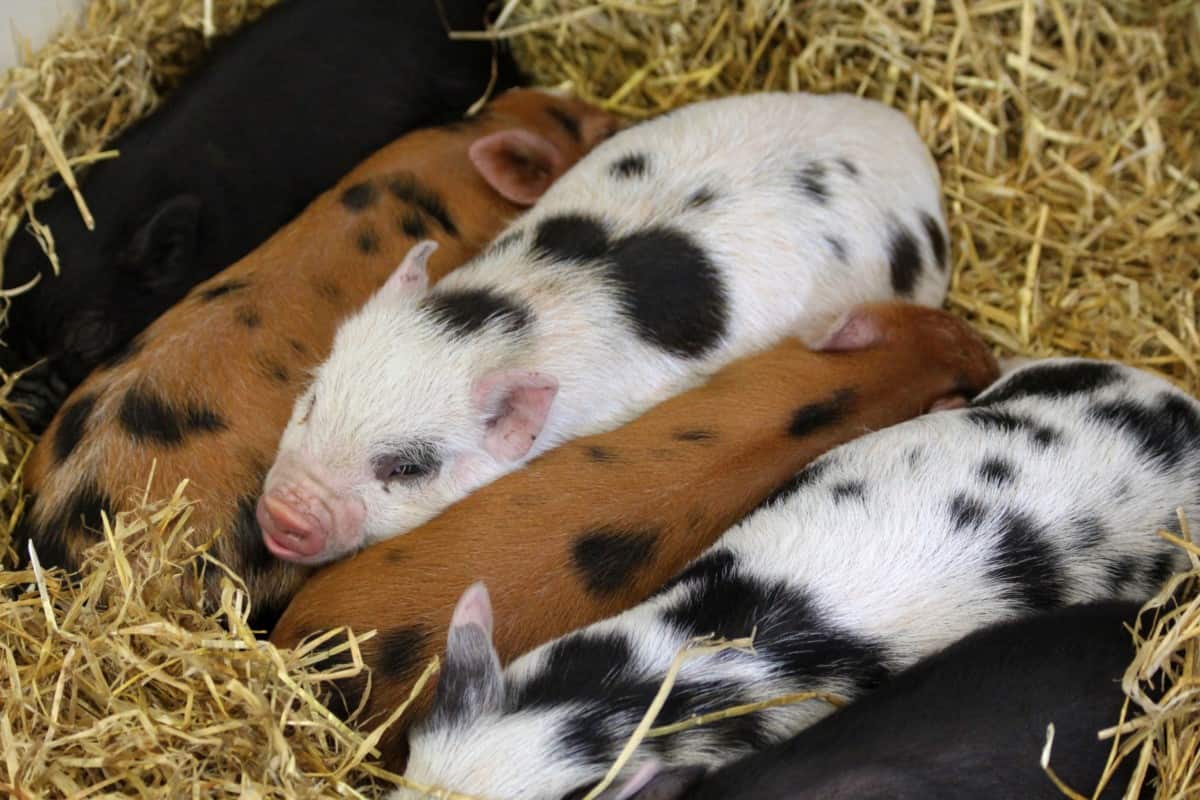The birthing of pigs, which is also called farrowing is a delicate process which requires whoever is handling it has full knowledge of conception and delivery in pigs and also the skill needed. This is to ensure that at the end of the birthing process both the mother pig and her children are alive and healthy.
Preparing the Farrowing Rooms
To prepare the pigs for farrowing, you should start by preparing their rooms. These are certain rules to follow to ensure a comfortable room for birthing.
- Ensure the rooms are warm enough and controls are reset for newly farrowed pigs.
- Ensure the room is quiet.
- Make sure the sows are ready to farrow.
- Ensure pigs are laid out under heat lamps. They should not be piling.
- Make sure the pigs are comfortable by watching and listening to the pigs.
- Ensure total airflow is not too high (20 cfm/sow) and ventilation is adjusted properly to avoid drafts and chilling pigs.
- Scrape crates twice daily.
- Induce the sows with care.
- Make use of induction to attend farrowings of sows with problem histories.
- Avoid inducing sows too early (no less than Day 114 of gestation). This is dangerous and can lead to low-viability pigs.
Prior Planning for Farrowing
To fully understand the details of the birthing or farrowing process it is necessary to understand the anatomy of the pig, its pelvis and the reproductive tract. As farrowing approaches, the vulva becomes enlarged, together with the vagina which leads to the cervix or opening into the womb.
You can insert a small lubricated hand or arm into the vagina to just beyond the cervix without inflicting any damage. When this is done, the neck of the cervix will open up into the two long horns of the womb. This is where the piglets are located. Just as in humans, the umbilical cord of the piglet terminates at the placenta.
The placenta is very visible as it is attached to the surface of the womb. Nutrients pass from the blood of the sow across the placenta and into the developing piglet. The placenta also extends around the piglet as a sac which contains fluids and waste materials, produced by the piglet during its growth.
Pregnancy
The expected length of pregnancy in the sow is between 114 – 115 days with a range from 111-120. Gilts sometimes have a shorter pregnancy. The variation within the range an be influenced by a number of things such as the herd, breed, environment, and the time of year.
STAGE 1
This is called the pre-farrowing period. The preparation for birthing or farrowing begins about 10 to 14 days to the actual date of delivery. This begin with the development of the mammary glands and the swelling of the vulva. This is also coupled with the enlargement of the teats. The veins supplying the udder stand out prominently.
When the pig begins to have a reduced appetite and gets restless, the time is set. You see the sow standing up and lying down and if bedding is available chewing and moving this around in her mouth.
If she is loose-housed on straw she will make a bed. Within 12 hours of actual delivery of piglets, milk is secreted into the mammary glands and with a gentle hand and finger massage it can be expressed from the teats. This is one of the most reliable signs of impending birth.
There may be a discharge of mucus on the vulva; it’s nothing serious. If a small round pellet of faeces is seen in the mucous and the sow is distressed, then farrowing has started. It is highly possible the first piglet will be presented backwards.
This small pellet is the meconium or first faeces coming from the rectum of the piglet inside. An internal examination is immediately required. Finally, to end this stage, you open the cervix and allow the pigs to be pushed out of the uterus, through the vagina and into the world.
STAGE 2
This is the farrowing process in detail. It sometimes goes from 3 to 8 hours. The piglets are usually delivered every 10 to 20 minutes but there is a wide variation. You can consult the sow and litter card to see if there have been any previous problems at farrowing.
It is important that a sow that shows a high rate of stillborn be monitored closely so if needed, necessary actions can be taken. For example if a sow has had high stillbirth rates, monitor her more closely and take any necessary actions. Having stillborn piglets can increase the chance of infection in the womb as the piglet may be rotting.
There is often a gap between the first and second piglet of up to three quarters of an hour. The majority of pigs are born head first but there are more pigs presented backwards towards the end of the farrowing period.
Immediately prior to the presentation of a pig the sow lays on her side, often shivering and lifting the upper back leg. It is essential that you watch out for this and take note of any such symptom as it may mean a stillborn is present. Twitching of the tail is seen just as a pig is about to be born.
STAGE 3
This stage is where the placenta is delivered. This usually takes place for about four hours if not less. It is an indication that the sow has finished farrowing although some afterbirth will sometimes be passed during the process of farrowing.
Once birthing is done, there are some signs that the pig will show that will make it obvious that the process is done.
First, she appears at peace, grunts and calls to the piglets. The previous shivering and movement of the top hind leg ceases. If this doesn’t stop, you should watch out. It is likely that a piglet is still presented.
After the placenta has been delivered, a slight but sometimes heavy discharge may follow for the next 3 to 5 days. If the udder is normal, the sow is normal and eating well, it is nothing serious and can be ignored. It is a natural post-farrowing process. Occasionally a pathogenic organism enters the uterus causing inflammation (endometritis). This may cause illness, requiring treatment and veterinary attention.
Common Problems Farrowing
Stimulating A Piglet To Breathe
It is possible sometimes that a piglet is delivered, and it fails to breathe. In cases like this, you take a small piece of straw and poke it up the nose. This will in many cases elicit a coughing reflex and remove mucus that has blocked the windpipe.
As an alternative to that, you can place the third finger across the mouth of the piglet with its tongue pulled forward. Place the rest of the hand around the head and hold the back legs. Swing the pig with a firm downward movement to propel any mucous from the back of the throat and the windpipe.
Uterine Inertia
This is where the womb has just stopped contracting. There are usually two or three pigs waiting just beyond the cervix. If they are in an anterior (facing forward) presented position, you can place your hand over the head with the first and second fingers around the nape of the neck.
If the piglet is presented in a breech or backward position raise both hind legs and clamp your hands around using the first and second fingers as leverage around the points of the hock.
Conclusion
The art of birthing pigs is a serious one and should be seen as such. There are many pigs with still births and other anomalies because those who deliver them do not see it as a big deal hence, they committed errors. With the guidelines above, you are sure to deliver healthy pigs.

